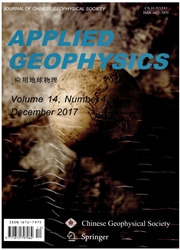

 中文摘要:
中文摘要:
动校正对于长偏移距地震资料尤其是深层反射的地震资料十分重要。基于短偏移距假设的传统双曲动校正方法或者基于连分式展开的动校正方法在长偏移距会失效。本文基于Pade逼近提出了一种适合于各向同性介质的长偏移距动校正新方法。理论分析和数值实验结果表明:该方法在长偏移距的动校正效果明显优于其它已知的动校正方法。传动校正方法在偏移距与深度比值为2时误差超5ms,该比值为3时误差超过10ms。相比之下,[3,3]Pade逼近动校正方法在偏移距与深度比值为3的误差不超过5ms。在Cooper盆地Tirrawarra井据合成的平层模型实验中,[3,3]阶Pade逼近动正方法的偏移距与深度比值有效范围是其他动校方法的两倍以上。[7,7]阶Pade逼近动校正方法精度较[3,3]阶Pade逼近具有更进一步的提升。
 英文摘要:
英文摘要:
The nomaal moveout correction is important to long-offset observations, especially deep layers. For isotropic media, the conventional two-term approximation of the normal moveout function assumes a small offset-to-depth ratio and thus fails at large offset-to-depth ratios. We approximate the long-offset moveout using the Pade approximation. This method is superior to typical methods and flattens the seismic gathers over a wide range of offsets in multilayered media. For a four-layer model, traditional methods show traveltime errors of about 5 ms for offset-to-depth ratio of 2 and greater than 10 ms for offset-to-depth ratio of 3; in contrast, the maximum traveltime error for the [3, 3]-order Pade approximation is no more than 5 ms at offset-to-depth ratio of 3. For the Cooper Basin model, the maximum oft'set-to-depth ratio for the [3, 3]-order Pade approximation is typically double of those in typical methods. The [7, 7]-order Pade approximation performs better than the [3.3]-order Pade armroximation.
 同期刊论文项目
同期刊论文项目
 同项目期刊论文
同项目期刊论文
 期刊信息
期刊信息
